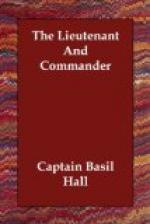FOOTNOTES:
[2] On the renewal of their Charter, in 1833, the East India Company ceased to be traders, and these noble ships no longer sail under the Company’s flag.
CHAPTER VI.
The trade winds.
There are few things more curious in the history of human knowledge than the establishment of extensive errors as to matters of fact, and the perverse tenacity with which they retain their hold on the public mind. In some cases it would almost seem that the pleasure which springs from genuine philosophical inquiry is subordinate to that which arises from the indolent process of taking things for granted. This applies peculiarly to the phenomena of the Trade-winds, respecting which many erroneous ideas are generally entertained. To professional men these fallacies are calculated to prove extremely mischievous; while even to persons not directly connected with the sea, the existence of error may often be injurious: and, although it is not very easy to explain these things in a popular way, I shall attempt to give a description of the facts as they really exist.
The main characteristics may easily be described.
The great belt of the earth’s surface, nearly three thousand miles in width, lying between the tropics (from 23-1/2 deg. north to 23-1/2 deg. south latitude), is the chief region of the Trade-winds; though in some parts of the world they extend to the latitude of 28 deg. both north and south of the equator; while at other places well within the tropics, and even close to the line, totally different winds prevail. It is only in the open parts of the Pacific and Atlantic oceans that the true Trade-winds blow. In the Indian and China seas, and in many other portions of the great tropical belt, periodical winds, called Monsoons, are found. These shifting Trades exact the closest study from the practical navigator, in consequence of their extensive variety and seeming complication. But they are not less deserving the attention of merely curious inquirers, from the beautiful manner in which these modifications of the regular breezes obey the same general laws which direct the grand phenomena of the Trades. Indeed, the most extensive observation serves only to link the whole into one harmonious chain or series of explanations, exhibiting the uniformity as well as the exquisite adaptability of Nature, even in those departments called “inconstant,” where she is supposed to be most capricious.
The only general assertion that can safely be made with respect to the Trade-winds is, that they blow more or less from the eastern half of the compass towards the western. On the north side of the equator, the north-east Trade-winds blow; and on the south side, the south-east Trade-winds. These two names have undoubtedly contributed to mystify the subject by naturally suggesting to the imagination




